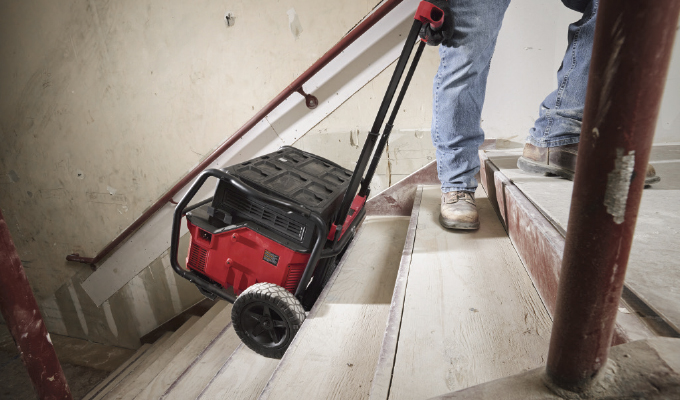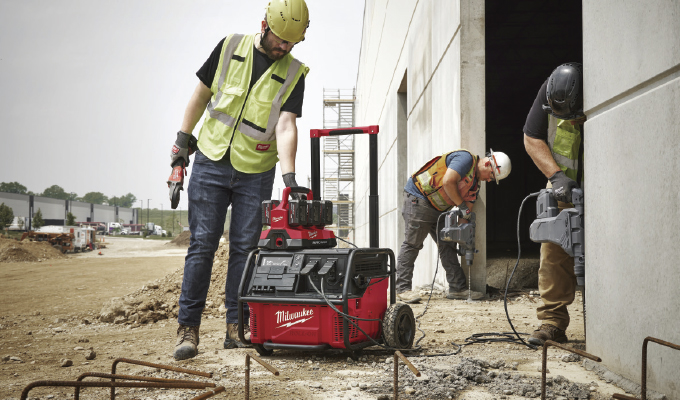Many trades professionals are familiar with the frustrations of limited or no power on jobsites, relying on gas-powered generators or temporary power solutions. Power is essential for ensuring operational efficiency on these sites.
With modern battery powered innovations, implementing solutions can mitigate risks, enhance productivity, and reduce emissions. As battery technology continues to advance, it is improving jobsite power management, fostering more resilient and sustainable practices. Current crews are increasingly more aware of and demand safer more efficient alternatives, rejecting the traditional drawbacks of gas fumes and corded solutions on jobsites.
HISTORICAL CHALLENGES OF POWER ON JOBSITES
Gas-powered generators and spider boxes have long been relied on for completing work, but they come with significant challenges and limitations. Gas-powered generators are notorious for their noise, emissions, and the frequent need for refueling and maintenance. The reliance on gasoline introduces risks of spillage, hazardous fumes, and engine failures, which can lead to costly downtime and interruptions. Additionally, the cumbersome nature of these generators complicates productivity and safety on site, and they cannot be used indoors due to carbon monoxide risks.
Spider boxes or power distribution boxes are used to manage and distribute power from a single source to multiple tools and devices. However, they often present their own set of problems. Common issues include tripped breakers, voltage drops, and the need for extensive extension cords due to their distance from the work area. This not only creates hazards but also reduces efficiency by leading to overcrowded outlets and increasing the risk of electrical faults, further complicating power management.
The complexity of power access is exacerbated in remote locations or situations requiring mobility. As jobsites move further from established power sources, the challenge of providing consistent and adequate power becomes more pronounced. Large equipment and the need for temporary power solutions in these environments often require intricate setups involving heavy extension cords and multiple power sources. This not only complicates logistics but also heightens the risk of power disruptions, safety hazards, and reduced operational efficiency.

BENEFITS OF MODERN BATTERY-POWERED INNOVATIONS
Modern battery-powered solutions address many of the safety and operational challenges associated with historical power sources. Unlike gas-powered generators, which pose risks such as carbon monoxide exposure, fire hazards, and electrical shocks, battery-powered systems offer a safer alternative. OSHA states that generators can emit hazardous fumes, require proper ventilation to avoid carbon monoxide poisoning, and present fire risks due to flammable fuels and improper refueling practices.
Battery-powered units eliminate these risks with no emissions while in use, reducing concerns about carbon monoxide and fire hazards associated with gasoline. They also avoid the noise issues common with traditional generators, which can impact worker comfort and hearing.
Overall, these advancements reflect a significant shift towards safer, more efficient, and emission free power management on jobsites, aligning with OSHA’s guidelines for reducing workplace hazards.
ADVANCEMENTS IN BATTERY TECHNOLOGY
In the evolving landscape of jobsite power solutions, Milwaukee Tool offers battery-operated systems. The introduction of its MX FUEL CARRY-ON 3600W/1800W power supply and the ROLL-ON 7200W/3600W 2.5kWh power supply marks a step forward in portable power technology. By moving away from traditional gas-powered generators and spider boxes, these solutions offer enhanced efficiency, reduced emissions, and improved safety, providing professionals with reliable and versatile power.
The MX FUEL CARRY-ON offers a quieter, no emissions while in use alternative to historical power supply options. It delivers 3,600 peak watts and 1,800 running watts of pure sine wave energy, making it suitable for both high-demand tools and sensitive electronics. Its compact design, roll cage, and push-button start enhances portability and ease of use, reduces the typical hassles of manual pull starts and gasoline maintenance. It is ideal for indoor and outdoor environments, contributing to greater safety and operational efficiency while minimizing noise and environmental impact.
The ROLL-ON is engineered to handle high-demand applications effectively offering 7,200W of starting power and 3,600W of running power. It features a non-removable integrated 2.5kWh battery, which provides high power and runtime to sustain high-demanding applications. This enables it to support multiple 20A corded tools, chargers, and sensitive electronics simultaneously. It includes (2) 20A GFCI duplex outlets with circuit breakers, USB-C, and USB-A ports, and its pure sine wave inverter ensures clean power output, protecting sensitive devices. With quiet operation and an IP54 rating for durability in harsh conditions, It is suited for indoor and temporary outdoor use.
SHAPING THE FUTURE
New battery technologies are advancing rapidly, providing enhanced power, durability, and ease of use. These innovations are not just improving jobsite efficiency but are also driving a shift toward safer and more sustainable practices. By embracing these advancements, the industry is shaping a future where power management is redefined, setting new standards for operational excellence, and reducing reliance on outdated and hazardous solutions.
ABOUT THE AUTHOR
Jake Van Wormer is the group product manager at Milwaukee Tool. To learn more, visit www.milwaukeetool.com.




